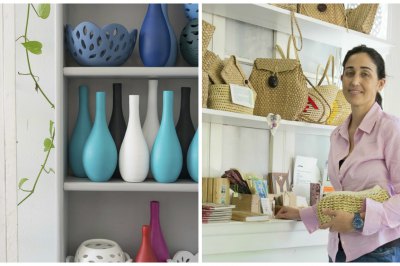In Cuba, limitations can mean innovation for craftspeople

On Julie’s recent travels to Havana, Cuba, she had the opportunity to visit Alma, a local shop-meets-concept space designed to propel the voices of Havana’s artisans. Alexandra Oppmann, Alma’s visionary and founder, collaborates closely with local artisans to curate a design-forward array of fashion and accessories and home goods that she sells at Alma. In a resource scarce environment with major limitations on market access, the sales opportunity that Alma provides for Cuba’s artisans is widely needed.
A mother of three, Alex held her three month-old baby in her arms as she and Julie chatted in the small garden attached to Alma. Alex’s reflections on the state of artisanship in Cuba evokes the idea of scarcity as an unexpected mother to innovation and creativity.
Julie: How did you transform Alma from a passion project into a business and store?
Alex: It took a while to find artisans and designers to work with – like all relationships, these partnerships take time to develop and there can be challenges along the way. For example, the woodworkers we partner with Baracoa have beautiful wood, but perhaps not the most interesting designs. So I took a bit of a collaborative approach: I provided them with some images to translate their technique to.
Sometimes, designs in Cuba can be stuck in a rut. If you go to the market in Havana, you’ll see that 90% of the items appear mass produced, because everyone is making the same thing, thinking that’s what is going to sell. I try to play a role in shifting this mindset. For example, I asked a man making traditional straw bags to try producing a clutch design I had given him to work with. To mollify his worries that these clutches wouldn’t sell, I told him that I personally would buy all un-purchased products. What was the result of his risk-taking? He tells me those clutches are his top-sellers.
Julie: How do you find the artisans that you collaborate with?
To get started, I walked around the markets in Havana and spoke to the artisans selling directly to shoppers, without use of a website or a store. For those artisans based outside Havana around other parts of the island, I often met them through people I know.
One friend referred me to artisans from Trinidad doing beautiful traditional embroidery for tablecloths. They are facing challenges securing fabric, so they purchase bed sheets to work with. It is not ideal. My dream is to get the group some very nice linen; however, it’s difficult to import linen in large quantities. Whatever is coming into the island, has to come in your suitcase, and the government stores here don’t really sell high quality fabric. What they do sell of it is too expensive.
Julie: How do the artisans you work with learn the crafts that they practice?
Alex: The process is very familial. For the women embroiderers, this is a skill passed down from generation to generation – and there is no one else in the world practicing this type of technique. When I visit the artisans, I will find the women on their front porches in the sun, working away alongside mothers, sisters, cousins, and aunts. It is similar for our woodworkers, as well. It is often the father, son, and cousin all working together.
Juli: What impact do you think the Revolution had on the artisan landscape in Cuba?
Alex: There are two sides to answering this question. On the one hand, the artisan is now limited by lack of materials. On the other hand, this lack of material is driving inventiveness and resourcefulness. Take for example, Mariana who takes apart watches and uses the parts for her creations: would she choose to make jewelry in this fashion if she had access to all the tools and materials she needed? No. But yet, something beautiful and unexpected has come out of that limitation – one that likely would not have happened otherwise.